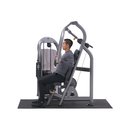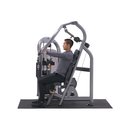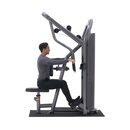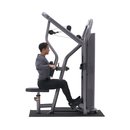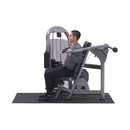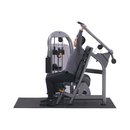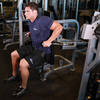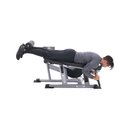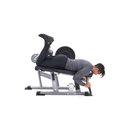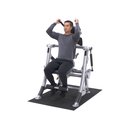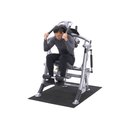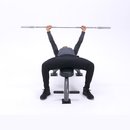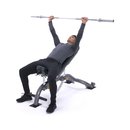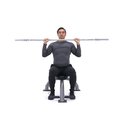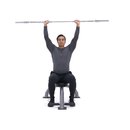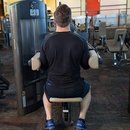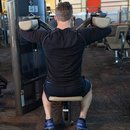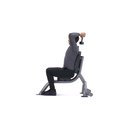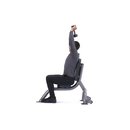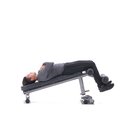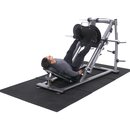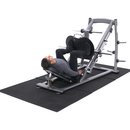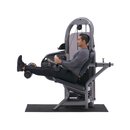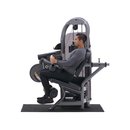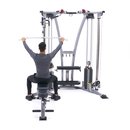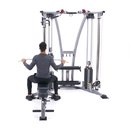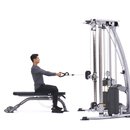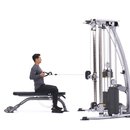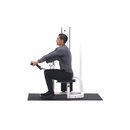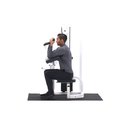Ever try running in water? It's a lot harder—and you move noticeably slower—because the resistance of the water is greater than when you run on land. More resistance also means your muscles have to work harder.
Resistance training is simply a form of training in which you're working against some type of force that "resists" your movement. Most people are familiar with weightlifting, but there are other kinds of activities that fall under the heading of resistance training, including bodyweight exercises, dragging sleds, running with parachutes, and even movement in water.
Learn the basics, then follow the 10-week resistance-training plan to build size and strength!
Get Started Right
A weight workout can consist of several kinds of equipment, including free weights (barbells, dumbbells, plates), machines, cables, and even some bodyweight moves. In your early phases, it's important to rehearse movement patterns that are probably new to you, which is why this beginner's program relies on machines and barbells—the easiest kinds of equipment to use.
Only after you feel comfortable controlling the weight and maintaining the correct body position should you graduate to heavier weights or more challenging movements. You do that by practicing the basic movement patterns over and over with fairly light weights until they become second nature.

A weight workout can consist of several kinds of equipment, including free weights (barbells, dumbbells, plates), machines, cables, and even some bodyweight moves.
The workout below starts off by teaching you the most basic movement planes to cover all the major muscle groups: chest, back, shoulders, quads, glutes, hamstrings, biceps, and triceps. Each major body part is included in this workout, which can be repeated three times a week for the first five weeks.
Following this approach rather than randomly doing exercises in the gym ensures not only complete and symmetrical development, but also that you'll make steady progress, keeping you motivated and on track toward reaching your goals.
Below are seven of the most important parameters in your quest to build size and strength.
1. Choose the Right Exercises
Some exercises are better—way better—for building muscle than others. Choose moves that are multijoint in nature. That means an exercise is a better choice if movement is occurring at two or more joints. The muscles attached to those joints are either contracting or lengthening. When more muscles are involved, you can move more weight, producing a greater stimulus.
Multijoint exercises are more challenging than single-joint movements, and this makes them superior for building muscle. Compare the bench press (shoulders and elbow joints) versus the dumbbell fly (elbows only), or the squat (ankles, knees, hips) versus the leg extension (knees only). The multijoint movements always allow you to recruit more muscle groups and therefore lift more weight.
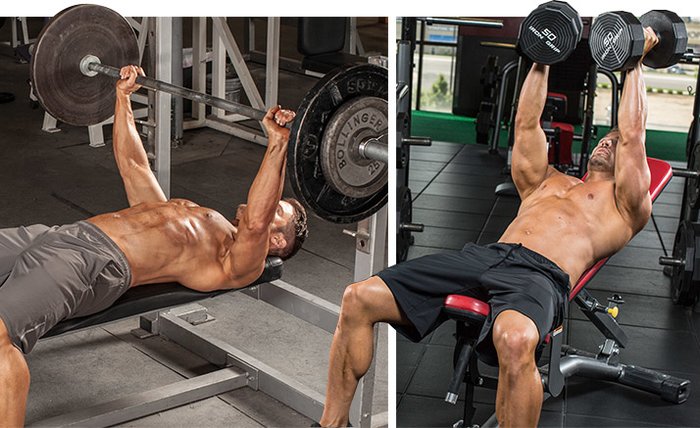
Multijoint exercises are more challenging than single-joint movements, and this makes them superior for building muscle. Compare the bench press versus the dumbbell fly, or the squat versus the leg extension. The multijoint movements always allow you to recruit more muscle groups and therefore lift more weight.
Do these kinds of movements first in your workout, after warming up, when you're fresh. If you choose to do single-joint movements, save them for the end of your workout.
Note: Some smaller muscle groups like biceps, forearms, and calves consist only—or mainly—of single-joint exercises, so you'll do these "isolation" exercises for these body parts.
2. Choose the Proper Weight
After warming up, choose a weight that allows you to just reach your target rep with good form. If you have to cheat the weight up or otherwise throw your back into it, that doesn't qualify as a clean rep. It will, however, increase your risk of injury.
The target rep ranges presented aren't just random numbers that were pulled from the sky. In fact, researchers have identified the 8-12 range as being ideal for building muscle, assuming you're approaching muscle failure—meaning you picked the right weight—and you're using good form. That rep range also builds a good deal of strength; however, when you progress to more advanced training, you might train in lower rep ranges of less than 6, which are even better for strength building.

After warming up, choose a weight that allows you to just reach your target rep with good form.
As a novice, you want to steer clear of very heavy weight; instead, we've suggested fairly high rep ranges for the first couple of weeks, until you get a better feel for movement patterns. You'll see a gain in strength just by becoming more coordinated. Once you start training in the more moderate rep ranges, you'll be able to challenge yourself with heavier weights.
As the rep target drops, say from 12 to 10, opt for a slightly heavier weight. If you choose a weight for a rep target of 10 but could instead do 15, that weight is too light and should be increased on your next set. Likewise, if you can do only 8, it's too heavy.
Remember, never sacrifice form to lift a weight that's too heavy.
3. Do Multiple Sets of an Exercise
Warm-ups don't count toward your set total; they're sets in which you rehearse the movement pattern to simply, well, warm up the muscle tissue, making it more elastic.
But don't underestimate their importance, especially as you take your training to higher levels. Without a proper warm-up, you won't be able to reach your potential max weight. Do as many warm-up reps as you need to, but never take those light sets to muscle failure.
If warm-ups don't count, how many sets are optimal? While just a single set provides some benefit, you'll get even more if you do multiple sets of a movement—as many as 3-4. Doing that many sets will allow you to fine-tune the amount of weight you're using.
4. Control the Motion
Regardless of whether you're using a light or heavy weight, control the motion. Here's a good way to perform your reps: Inhale and hold your breath as you lift the weight in a strong and forceful manner, exhaling only over the top portion of the movement.
Then lower the weight under control as you breathe in. Reverse direction smoothly at the bottom position, never bouncing the weight at the bottom. It will become second nature with time.
5. Take a Short Rest Between Sets
By design, muscle failure occurs when you can't complete another rep with good form. If you've chosen the right weight, it occurs in the 8-12-rep range. As your muscles fatigue during a set, they need time to clear metabolic byproducts—hydrogen ions and lactate—which takes time.

As your muscles fatigue during a set, they need time to clear metabolic byproducts—hydrogen ions and lactate—which takes time.
This usually requires 90-120 seconds, although larger body parts like legs and back may take longer, and smaller muscle groups like arms and calves may take less time. A good measure is when you catch your breath and feel ready to go again.
6. Wait at Least 48 Hours Before Repeating a Workout
Some newbies might be stunned to learn that resistance training does not build muscle. Rather, it actually begins a process in which muscle building can occur in the presence of sound nutrition and adequate rest. It's the initial stimulus that begins a chain of events that causes the muscle to repair itself and make itself stronger the next time you hit the gym. Shortchange any of these factors, and you compromise your gains.
That being said, a trained muscle will experience soreness for a day or two afterward. It's normal and called delayed-onset muscle soreness, or DOMS. That soreness is a sign that a muscle isn't completely recovered from a previous training session, and recovery is when growth takes place. That muscle group shouldn't be targeted again for about 48 hours after you last trained it.

Some newbies might be stunned to learn that resistance training does not build muscle. Rather, it actually begins a process in which muscle building can occur in the presence of sound nutrition and adequate rest.
Be aware that some body-part splits such as chest on Mondays, shoulders on Tuesdays, and triceps on Wednesdays—all push muscles—can mean that some areas are getting worked on back-to-back-to-back days. Careful consideration of how you arrange your training split can avoid this overtraining scenario.
As you become more advanced and add volume to your body-part routines, you'll want to increase that between-workout rest period, meaning you'll decrease the frequency with which you train a particular body part.
7. Do a Little More Each Workout
So let's say you train properly, eat and supplement right, and rest adequately. What's the payoff? Gains in muscle size and strength. Muscle fibers grow bigger and stronger by adapting to the stimulus, so instead of being able to do just 10 biceps curls, you can now do 12. That's great, but now instead of going for 13 or 14, add more resistance to the bar. This will ensure you're still working in the target rep range of 8-12. Sure, you won't be able to do as many reps when you add weight, but you begin the process anew of striving to do more reps, this time with a heavier weight.

Triceps dip machine
The idea isn't that you simply want to overload the muscles to encourage growth, but that you need to do it progressively over time. Strive to do more reps with a given weight or increase the weight from one workout to the next—that's the progressive stimulus you need in order to keep making improvements. Fall into a comfort zone, and your growth comes to a grinding halt.
Your 10-Week Plan
Over the course of the 10 weeks, we've established important goals for each section, which build on one another. Not all of them are based on increasing the amount of weight, so pay attention to what's listed in each section. Some important concepts are integrated into the two five-week programs—including increases in volume and intensity—that are important aspects of a successful bodybuilding program. The better you understand how and why these variables are manipulated, the greater and more consistent progress you'll make over time.
Goals for the 10-Week Beginner's Program
Weeks 1-2
- Learn how to adjust the machine correctly for your body type.
- Learn basic movement patterns and how to control the weight when raising and lowering it.
- Start with a 5-10-minute full-body warm-up.
- Do 2 sets of one exercise for each of the major muscle groups. Each set is taken to 15 reps.
- Learn how to choose a weight so that you can reach the target rep.
Weeks 3-5
- Increase the volume by adding a third set.
- Increase the weight so that you're working in the 10-15 rep range.
- Learn how to increase the weight from one set to the next for fewer reps (pyramid training).

EZ-bar biceps curl
Week 6
- Learn free-weight or barbell variations of slightly different moves for each body part.
- Keep reps high as you again learn new movement patterns.
- Add a second exercise for each muscle group, hitting the target body part from a slightly different angle for more complete development of the target muscle.
- Increase the volume of work done for each body part (4 total sets versus 3) while reducing its training frequency from three times a week to two.
- Learn how to divide your training split into push (chest, shoulders, triceps, abs) and legs/pull (back, biceps) days.
- Increase your training days from three to four.
Weeks 7-10
- Increase the weight so you're working in the target rep range of 8-12. As the weight goes up, the number of clean reps you can complete falls.
- Increase the volume of work again for each muscle group by adding a third set of each exercise.
- As you get stronger over the course of the program, do more reps and/or increase the weight to progressively challenge the working muscles.
- If a given barbell or dumbbell exercise is too difficult, find its machine counterpart and practice on that before going back to free weights.


